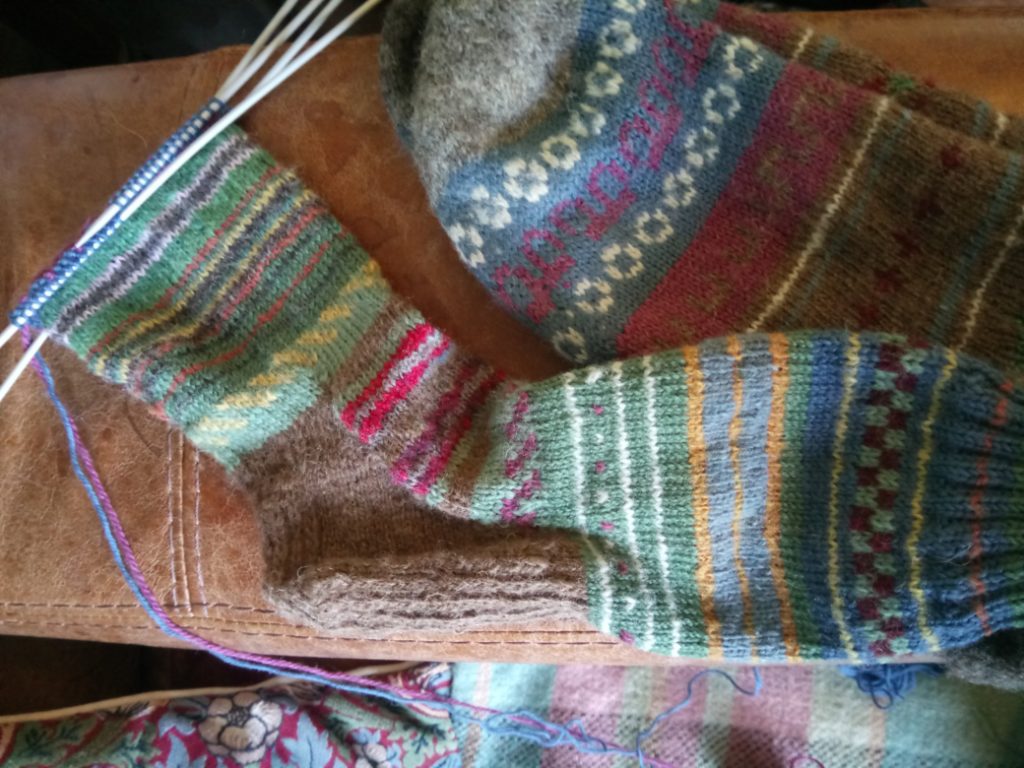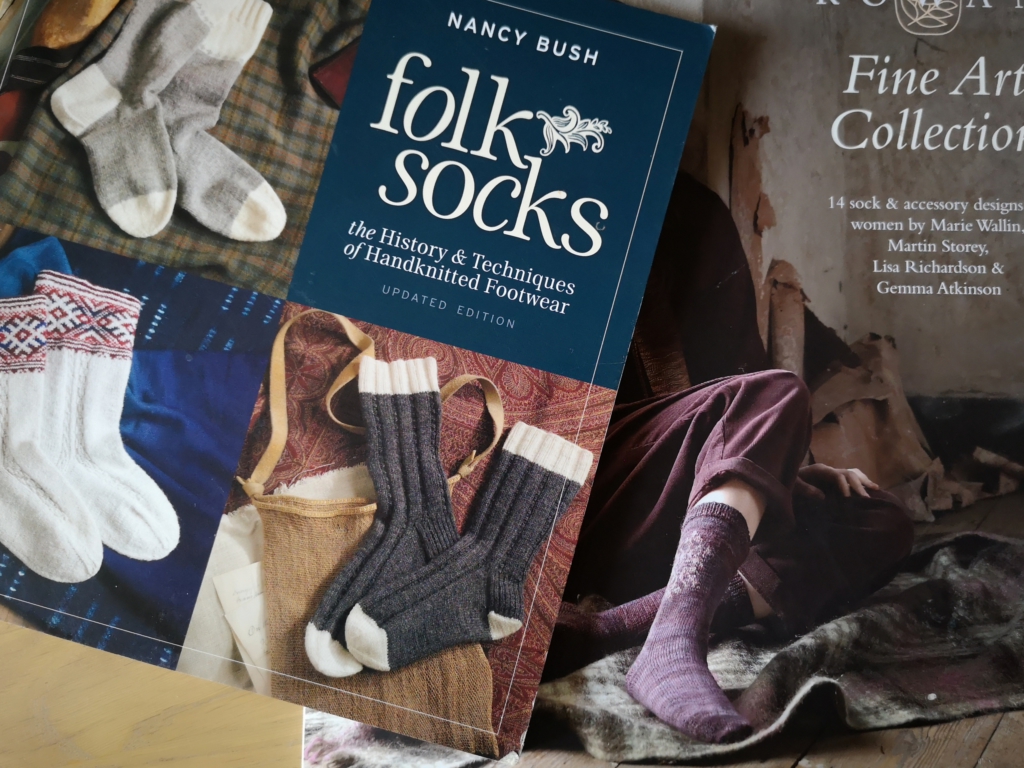Once upon a time everyone wore socks that contained no nylon. The idea of no nylon socks would never have occurred to anyone. We darned (undeniable). So who wouldn’t blame people for wanting a sock that took an age to need darning, and were so cheap that you’re more likely to discard than darn?
They probably aren’t an article of clothing that you would most associate with nylon. But it’s hard now to find a pair of socks that doesn’t contain at least some nylon or synthetic fibres. Pure wool socks are hard to find. That there were specific ways that you could knit socks that lengthened the time between darning never occurred to me until I saw a link to a No Nylon Sock knitting project (a Knit-a-Long) run by Joeli Creates.
It was promoted in a Woolsack newsletter. I wasn’t in a position to join in with the project at the time, but I made a mental note about why the project was set up. It seems the project involved trialling how well different fibres used in a handknit sock stand up to wear and tear, compared to a yarn that includes nylon.
The project was a response to research into synthetic fibres and other plastics in our oceans, and the problems they are causing. See this article in The Guardian about synthetic fibres and microbeads in the food chain.
I’d come back round to thinking about sock knitting as I was planning ahead what I might like to knit over the autumn and winter. I’d also bought a discounted book of mainly sock patterns bought at the haberdashery closing down sale that I mentioned in Ode to the haberdashery department. So my thoughts turned to socks.
The Plastic Microfibre Problem
I liked the look of the Fine Art Sock yarn in the book I’d bought, but noticed that it contains 25% polyamide. Despite how pleasing it is on the eye, I couldn’t help but think of the tiny little nylon fibres escaping from the washing machine or down the plug hole. From my house, they’d swirl down the River Severn, past the trendy bars along Bristol waterfront, into the Severn Estuary, then the Atlantic ocean. How long before they wash up on a palm-fringed Caribbean shore, or get sucked up by a turtle? That’s about 25g per pair of socks on a long journey, wash by wash.
I sometimes wonder if I’m being too purist. After all, a little nylon from the socks emerging from the needles of knitters around the country, or even the world, must be infinitesimally small compared to all the synthetic fibres wearing off the clothes people wear. So where do you draw the line between significant and not significant?
Nylon pollution from clothes, though, is something that is now getting more attention. During Zero Waste Week 2018, I considered plastic microfibre pollution from our clothes, and the issue of plastic-free sportswear. Socks are one part of this problem.
No Nylon Socks – Buy or Make
You can buy socks made from pure wool or other natural fibres online – usually hand-knitted. They will cost considerably more than a standard pair bought from a high street store. You might wonder why you would, but then there’s no comparison. Wool, or other natural fibres, have a much more distinctive look and feel compared to machine knit cotton-lycra or mixed fibres. They’re usually thicker, there’s stitch definition, and then there’s an unparalleled warmth and breathability. If you’re prepared to darn occasionally, they’re worth the money – and you’re contributing to the livelihood of a crafter.
We’ve managed without nylon in our socks for centuries. There are different sock knitting traditions around the world; and they often include various tricks that extend the length of time between darns.
I know that there are several techniques that make handknit socks more durable or more easily mended. I’ve researched a little online and for the sock knitter, I present here a list of No Nylon Sock making tricks. For the sock buyer, you might want to check out the sock reinforcing or other sock maintenance tips:
Knitting Tricks:
- Knit with a tighter ply yarn or spin yarn for sock knitting with more plies (3 ply rather than 2ply)
- Keep your tension/gauge slightly tighter than normal
- Use a stitch pattern that pads and elasticises the heel. Try a slip stitch heel
- Use a sock pattern where the sole of the sock is knitted separately to the rest of the foot (see Elizabeth Zimmerman moccasin sock below)

No Nylon Yarn Options
- Use a yarn with some mohair or silk for strength and durability to take the place of nylon
- Avoid merino wool – it’s a soft, not very durable wool
- For rugged outdoor socks try Herdwick, for example
A Low Nylon Option:
- Knit with a regular yarn but knit in nylon thread just to reinforce the heel and the toes
Sock Reinforcing
- Give Them Strength – Reinforce!
- Darn the heel and toe when new to reinforce from the start
- Similarly, in a colour that will blend in, sew running stitches across the sole of the foot if that’s where you tend to wear your socks through
Make Mending Easier With a Separate Sole
I have previously knit a pair of moccasin socks from Elizabeth Zimmermann’s Knitter’s Almanac. The upper part of the foot is knitted, then stitches picked up, and the sole of the foot knitted in. The sole of the foot can then be unravelled and re-knitted when holes appear.
I knitted these for my husband, Andy, who unfortunately put them in the washing machine on a non-wool cycle which shrunk and felted them. To a size that fit me perfectly. I gained; he lost out.
As a result I have an unexpected pair of socks, but can’t test the unravelling of the sole now that they’ve felted. Elizabeth Zimmermann recommend knitting in nylon at the heel and toe, which I did for those socks. I have since, though, knitted another pair which I describe in Refootable Socks and a Mending Culture Revival. I’ve tested a slip stitch heel, and may try a moss stitch toe for durability.
How much do mohair or silk fibres take the place of nylon in adding strength to sock yarn? I’ve not yet bought any natural fibre sock yarn that contains these fibres, so I don’t yet know. I’m still trying to use up my yarn stock with knitting and reinforcing tricks before buying more yarn.
Are No Nylon Socks a Little Act of Eco-consiousness?
Whilst thinking about writing this post, I came across a thought-provoking video called Forget Shorter Showers. A somewhat apocalyptic view of the destruction being wrought upon the earth. The author, Derrick Jenson, argues that retreating into our own personal little acts of eco-consiousness (that would probably include me avoiding nylon in socks) will not do much to save the earth. So for instance, forget taking shorter showers.
We need to tackle the big polluters – the industrial giants and agri-industry. I agree, but there’s a sneaky little feeling that it misses a point. After all, who are the people who are most likely to petition against the big polluters or for changing national and inter-national laws? Those very people who try to recycle more, save water and eschew plastic.
The ban on free plastic bags in shops probably started with a few people who started taking their own bags whilst shopping. They made a bit of a noise about it, and it grew from there. So, these things are rarely straight forward, and from little acorns bigger things do grow.
What if a few sock knitters returned to the old fashioned socks knitting ways? Then in response to their desperate search for no-nylon sock yarn (with tighter twist and/or with natural strengthening fibres), more yarn producers obliged? Such yarn is hard to get hold of in the UK, for instance. Patterns for tighter knit socks and slip stitch heels might become more common.
What if a few people decided to buy hand-knit, all natural fibre socks? Yes, even cotton-knit socks usually include nylon – in the form of lycra. It’s just a thought….


Never thought about the polyamide content of my handknitted socks. I switched to knitting my own because they keep my feet so much warmer, found they lasted much longer, and there were no annoying seams on the toes.
Won't the plastic debate apply to many wools used nowadays though by the mainstream? I do try now to buy a higher wool content, but I have been known to use a lot of man-made fibres back in the day…
Be interested to know how you get on withe these different patterns, maybe use them myself…
The plastic debate would apply to other yarns too. It is a difficult one because wool is generally more expensive. I think of it this way, that the extra cost pays for better quality materials, supports the wool industry, and at the end of their use, they can just rot back into the ground. Ha, recycling socks back round the ecosystem sounds like a good idea to me!
Hi, thanks for sharing your findings! I stumbled across this sock yarn, which uses nettles or something for the 30%: http://www.ravelry.com/yarns/library/onion-knit-nettle-sock … it might be worth a try!
Apologies, your comment came through when I was finding it difficult to keep up the blog, hence a reply months later. I like your suggestion and hadn’t come across this yarn before. It looks like a good example to me of a yarn that includes a mix of fibres that strengthen the yarn, resulting in less darning of socks, one would hope! I would definitely buy some.
Hello – thank you for good information. I’ve recently learned my first socks, which are stitched sole-up, and the sole can be replaced. It’s Betty Salpekar’s Solefull Socks method. I’m hoping to try Elizabeth Zimmerman’s Moccasin Sock method soon. Thanks again!
Hi Christine, I’m glad you enjoyed the post. And, in return, thanks for the heads up about Betty Salpekar’s Solefull Socks method. Liz